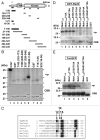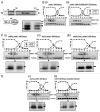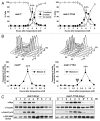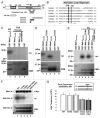The Mek1 phosphorylation cascade plays a role in meiotic recombination of Schizosaccharomyces pombe
- PMID: 21084840
- PMCID: PMC3048037
- DOI: 10.4161/cc.9.23.14050
The Mek1 phosphorylation cascade plays a role in meiotic recombination of Schizosaccharomyces pombe
Abstract
Mek1 is a Chk2/Rad53/Cds1-related protein kinase that is required for proper meiotic progression of Schizosaccharomyces pombe. However, the molecular mechanisms of Mek1 regulation and Mek1 phosphorylation targets are unclear. Here, we report that Mek1 is phosphorylated at serine-12 (S12), S14 and threonine-15 (T15) by Rad3 (ATR) and/or Tel1 (ATM) kinases that are activated by meiotic programmed double-strand breaks (DSBs). Mutations of these sites by alanine replacement caused abnormal meiotic progression and recombination rates. Phosphorylation of these sites triggers autophosphorylation of Mek1; indeed, alanine replacement mutations of Mek1-T318 and -T322 residues in the activation loop of Mek1 reduced Mek1 kinase activity and meiotic recombination rates. Substrates of Mek1 include Mus81-T275, Rdh54-T6 and Rdh54-T673. Mus81-T275 is known to regulate the Mus81 function in DNA cleavage, whereas Rdh54-T6A/T673A mutant cells showed abnormal meiotic recombination. Taken together, we conclude that the phosphorylation of Mek1 by Rad3 or Tel1, Mek1 autophosphorylation and Mus81 or Rdh54 phosphorylation by Mek1 regulate meiotic progression in S. pombe.
Figures







Similar articles
-
The fission yeast meiotic checkpoint kinase Mek1 regulates nuclear localization of Cdc25 by phosphorylation.Cell Cycle. 2008 Dec;7(23):3720-30. doi: 10.4161/cc.7.23.7177. Epub 2008 Dec 13. Cell Cycle. 2008. PMID: 19029820
-
Regulation of meiotic progression by the meiosis-specific checkpoint kinase Mek1 in fission yeast.J Cell Sci. 2003 Jan 15;116(Pt 2):259-71. doi: 10.1242/jcs.00232. J Cell Sci. 2003. PMID: 12482912
-
Rad3-Cds1 mediates coupling of initiation of meiotic recombination with DNA replication. Mei4-dependent transcription as a potential target of meiotic checkpoint.J Biol Chem. 2006 Jan 20;281(3):1338-44. doi: 10.1074/jbc.M505767200. Epub 2005 Nov 14. J Biol Chem. 2006. PMID: 16286472
-
The meiotic-specific Mek1 kinase in budding yeast regulates interhomolog recombination and coordinates meiotic progression with double-strand break repair.Curr Genet. 2019 Jun;65(3):631-641. doi: 10.1007/s00294-019-00937-3. Epub 2019 Jan 22. Curr Genet. 2019. PMID: 30671596 Free PMC article. Review.
-
Rad3 and Sty1 function in Schizosaccharomyces pombe: an integrated response to DNA damage and environmental stress?Mol Microbiol. 2008 Apr;68(2):246-54. doi: 10.1111/j.1365-2958.2008.06147.x. Mol Microbiol. 2008. PMID: 18366437 Review.
Cited by
-
The meiotic checkpoint network: step-by-step through meiotic prophase.Cold Spring Harb Perspect Biol. 2014 Oct 1;6(10):a016675. doi: 10.1101/cshperspect.a016675. Cold Spring Harb Perspect Biol. 2014. PMID: 25274702 Free PMC article. Review.
-
CDK Regulation of Meiosis: Lessons from S. cerevisiae and S. pombe.Genes (Basel). 2020 Jun 29;11(7):723. doi: 10.3390/genes11070723. Genes (Basel). 2020. PMID: 32610611 Free PMC article. Review.
-
A knockout screen for protein kinases required for the proper meiotic segregation of chromosomes in the fission yeast Schizosaccharomyces pombe.Cell Cycle. 2013 Feb 15;12(4):618-24. doi: 10.4161/cc.23513. Epub 2013 Jan 31. Cell Cycle. 2013. PMID: 23370392 Free PMC article.
-
Structural basis of allosteric regulation of Tel1/ATM kinase.Cell Res. 2019 Aug;29(8):655-665. doi: 10.1038/s41422-019-0176-1. Epub 2019 May 16. Cell Res. 2019. PMID: 31097817 Free PMC article.
-
Essential and Checkpoint Functions of Budding Yeast ATM and ATR during Meiotic Prophase Are Facilitated by Differential Phosphorylation of a Meiotic Adaptor Protein, Hop1.PLoS One. 2015 Jul 30;10(7):e0134297. doi: 10.1371/journal.pone.0134297. eCollection 2015. PLoS One. 2015. PMID: 26225562 Free PMC article.
References
-
- Ciccia A, McDonald N, West SC. Structural and Functional Relationships of the XPF/MUS81 Family of Proteins. Annu Rev Biochem. 2008;77:259–287. - PubMed
Publication types
MeSH terms
Substances
Grants and funding
LinkOut - more resources
Full Text Sources
Molecular Biology Databases
Research Materials
Miscellaneous
